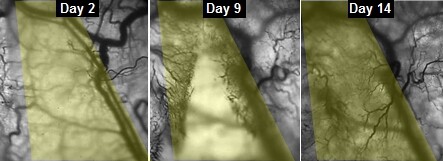The living skeletal muscle tissue grown by Duke University researchers is 10 times stronger than any previously bioengineered muscles. Not only does it contract as strongly and as rapidly as the real thing, but it is also capable of self-healing, both in the lab and after implantation into an animal. This has been proven beyond doubt through a novel approach that involves peeking at the growing muscle tissue through a glass window in the back of a living mouse.
Aided by Greg Palmer, an assistant professor of radiation oncology in the Duke University School of Medicine, the team of researchers placed their newly-developed muscle into a dorsal window chamber sealed with a transparent panel made of glass. The resulting peephole was then used to monitor the implanted tissue every second day over a two-week period.
The observation process must have been pretty spectacular. Not only were the strands of engineered muscle fiber stained to enable tracking their growth, but they were also coaxed into giving out fluorescent flashes whenever the muscles would contract, in response to sudden increases in calcium levels. As the muscles grew stronger, the flashes gradually picked up in intensity. Gradually, more and more veins grew into the implanted muscle fibers.

The group of scientists, led by associate professor of biomedical engineering Nenad Bursac and graduate student Mark Juhas, have identified that there are two secrets to creating better muscle. One is well-developed contractile muscle fibers and the other is creating the right conditions for satellite cells (muscle stem cells) to do their thing properly.
As it turns out, the key to making sure satellite cells can be successfully deployed in case of injury is creating the right kind of niches where such cells could wait for their turn to go into healing action. "Simply implanting satellite cells or less-developed muscle doesn’t work as well," said Juhas. "The well-developed muscle we made provides niches for satellite cells to live in, and, when needed, to restore the robust musculature and its function."

Needless to say, the scientists made sure the satellite cells did get their chance to shine. When still on a petri dish, the bioengineered tissue was exposed to a toxin obtained from snake venom. Once the researchers were sure the stem cells could activate, multiply and in effect heal the damaged tissue, the muscle was transferred into a mouse.
While the team has yet to explore if and how their bioengineered muscle can be used to address real muscle damage and degeneration, it is already clear that both the tissue in its current form and the developed in-vivo observation techniques are huge steps in this direction.
The muscle can be seen in the following video.
Source: Duke University






